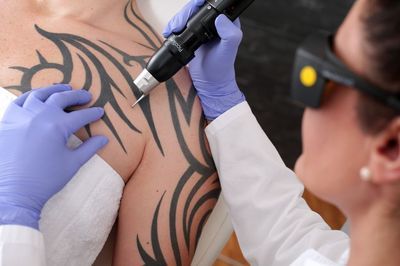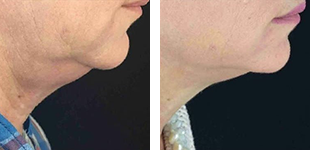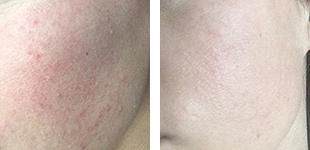Tattoo Removal
Conveniently located to serve the areas of Sunset Beach, Newport Beach, Redondo Beach, Orange, Dana Point and Orange County

Laser tattoo removal is the most common method of tattoo removal worldwide, largely because it offers effective and affordable results through easy, fast procedures with minimal pain. These methods have been around since the 1960s, but their refinement in recent years has placed them at the forefront of tattoo removal techniques. (1) Interestingly, the rates of tattoo removal are nearly identical to the rates of tattoo popularity. While there is nothing wrong with getting a tattoo, and the art, culture, and process certainly appeal to many people, having regrets about your tattoo and/or its placement is always a possibility.
At DermFx, laser tattoo removal is one of our most-performed procedures. Our talented specialists are happy to assist any patient in the Southern California area with their skin goals. When it comes to tattoo removal, we also have a strict policy about creating a judgment-free and welcoming environment for our patients. Our focus is entirely on helping you achieve the results you want to see. Schedule an appointment at your nearest DermFx office today to begin your tattoo removal sessions, or call one of our offices with any questions you might have!
Contents
About Tattoo Removal
As tattoos have grown in popularity in recent years, the rate of tattoo removal has increased as well. The technology incorporated into tattoo removal procedures has rapidly progressed, and patients see significant improvements with minimal scarring in only a few sessions. Tattoos do vary greatly in size, color, and density, and some respond more easily to treatment than others. Some colors are difficult to treat; including white, yellow, orange, and some red and green tattoos containing fluorescent or acrylic dyes. This is mostly due to the way different colors absorb different amounts of light; darker colors will absorb more light, with black absorbing the most. The more light a tattoo can absorb, the better it responds to removal. With our Picore laser, these difficult, less-absorbing colors are more easily treated than with older tattoo removal machines.
Why Are Tattoos Permanent?
Considering that our cells go through a lifecycle and that the outermost layer of our skin, the epidermis, is made up of mostly dead cells that are eventually shed, it can be hard to understand why tattoos remain permanent even as new cells form. We shed about 1,000,000 skin cells per day. (2) The main reason why tattoos are permanent is because ink is inserted below the outer skin layer and is embedded into the underlying tissue.
Each time the tattoo needle punctures the skin, it wounds the body, prompting a response from our immune system. In this process, macrophage cells absorb tiny amounts of ink to reduce inflammation at the site. (2) Some of these cells travel through the lymphatic system and are disposed of, and others remain at the tattoo site with no way of being removed from the body. These macrophages, as well as dermal cells called fibroblasts, absorb ink and will eventually die and be absorbed by new skin cells, leaving the ink inside of the new cell. (2) While tattoos do fade naturally over time, this process of cell death and absorption is what keeps tattoos in the skin permanently.
Benefits
Laser tattoo removal is an easy and effective way to remove the unwanted tattoos that are a source of embarrassment on your body. By coming to DermFx to remove your tattoo, you will experience benefits like:
- Quick results: Patients will see a significant reduction in their tattoo’s visibility after their first session. Most tattoos will take fewer than 12 sessions to completely disappear.
- Easy procedure: Many patients say that laser removal is less painful than receiving a tattoo. Our technicians are skilled with our lasers and have the experience to work quickly and accurately, so all you need to do is sit there while we work.
- Eliminated embarrassment: An unwanted tattoo can be an unsightly feature on your body. Removing it can mean removing a source of embarrassment.
- Enhanced confidence: You will be able to carry yourself the way you would like to without any unwanted ink on your body.
- Skin rejuvenation: While this is not the primary goal of tattoo removal, laser technology has similar effects to laser and microneedling skin rejuvenation. Your body will be prompted to produce collagen and hyaluronic acid as controlled micro-injuries affect your skin, and you will notice tighter, healthier, younger-looking skin at the treatment site.
Candidates and Personal Consultation
If you have a tattoo that you want gone, then do not hesitate to schedule an appointment at DermFx. Anyone with a tattoo they want removed is eligible for our services. At this initial appointment, we will examine the size and color of your tattoo and give you an estimate of how many sessions you will require to remove it. This number may change over time depending on how your body and your tattoo respond to treatment.
Procedure
Laser tattoo removal works by targeting the unwanted tattoo and exposing it to a beam of intense laser light, delivered in very short pulses. Each pulse of light disintegrates the ink with heat energy and acoustic waves, breaking it up into manageable particles that can be eliminated naturally by the body’s filtration system. (1) This essentially restarts the original tattoo healing process.
As ink deposits are shattered by the laser light, the body’s macrophages are prompted to absorb the loose ink and dispose of it through the lymphatic system. (2) The laser pulses are calibrated to match a specific light wavelength that will effectively eliminate the ink pigment in the skin. A key part of laser tattoo removal’s success is that the laser pulses need to be shorter than the time it takes for the skin to react and for the tattoo pigment to shed heat energy. This prevents the skin from protecting itself against the laser and means that the pigmented cells can be effectively eliminated. (1) Amateur tattoos and those done with a hand-poke method are normally eliminated faster because they are not embedded in the skin as deep. Professional tattoos may require more sessions to fully eliminate, especially those with thick, bold lines and vibrant colors like American Traditional styles.
Tattoo removal feels like a ‘stinging’ sensation to many; like an elastic band being snapped against the skin. If required, a local anesthetic cream may be applied to sensitive areas or simply to help you feel more relaxed. Some tattoo artists avoid using anesthetic creams when giving a tattoo because it can affect the healing and long-term integrity of the tattoo. However, utilizing it in laser tattoo removal will not affect your results or healing as the laser is still able to penetrate the skin deep enough to target the pigments with its full power. (3)
Recovery and Results
Some loss of pigment (hypo-pigmentation) or excess pigment (hyper-pigmentation) of the treated area may be evident after the completion of a treatment course. This will normally be expected to fade after 6 months, after which, normal skin coloring and texture should be regenerated. These conditions can also be complicated with exposure to the sun, so it is important to carefully adhere to your recovery instructions. (1) We also recommend that you apply sunscreen to any tattoo removal sites that are not covered by clothing, no matter how sunny or cloudy a day may be. We recommend keeping the skin covered for as long as possible, washing it a few times each day, moisturizing the skin, and avoiding touching and scratching it.
Cost of Tattoo Removal in Newport Beach

Most tattoos generally require 4-15 treatments performed at regular intervals to disappear entirely.(1) To ensure optimum success, an interval of 4-6 weeks is normal between treatment sessions. The exact number of sessions required depends on several factors, including the size, color, depth of ink, and type of tattoo. Our pricing for each session is based on the size of the tattoo and can be found below. For reference, a “medium” tattoo is about the size of your palm, whereas a “large” would be the size of your whole hand. “Extra large” normally refers to sleeves, back pieces, or anything larger than the size of your hands placed next to each other.
XS $99
S $150
M $250
L $350
XL $500
Call your nearest DermFx location below or complete an online form for more information.
FAQ
Does tattoo removal hurt?
Most patients report that removing the tattoo hurts less than receiving it and explain that the sensation is similar to a pinch or a snap from a rubber band. Patients can utilize a numbing cream during their procedure.
How many sessions are normally required?
Each tattoo will require varying numbers of sessions to see complete removal, but it will typically take between 4-15 sessions.
Do different tattoo styles respond differently to removal?
Yes. Smaller, fine-line tattoos, tattoos with less color, and amateur tattoos normally require fewer sessions. Larger tattoos with bold lines and intense colors will be harder to eliminate.
Can I get a new tattoo in that spot in the future?
If you want to get a new tattoo on the removal site in the future, you sure can! We just recommend that you wait until your tattoo has faded enough to not complicate the process and that you are certain that you want it. It is also beneficial to wait until the skin fully heals.
References
1. Henley JK, Zurfley F, Ramsey ML. Laser Tattoo Removal. PubMed. Published 2021. https://www.ncbi.nlm.nih.gov/books/NBK442007/
2. Baranska A, Shawket A, Jouve M, et al. Unveiling skin macrophage dynamics explains both tattoo persistence and strenuous removal. Journal of Experimental Medicine. 2018;215(4):1115-1133. doi:https://doi.org/10.1084/jem.20171608
3. Greveling K, Prens EP, Bosch N, Doorn MB. Comparison of lidocaine/tetracaine cream and lidocaine/prilocaine cream for local anaesthesia during laser treatment of acne keloidalis nuchae and tattoo removal: results of two randomized controlled trials. British Journal of Dermatology. 2016;176(1):81-86. doi:https://doi.org/10.1111/bjd.14848
 DermFx
DermFx


